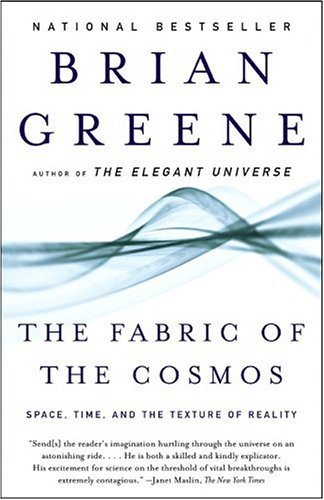The Fabric of the Cosmos: Space, Time, and the Texture of Reality
From Brian Greene, one of the world’s leading physicists and author the Pulitzer Prize finalist The Elegant Universe, comes a grand tour of the universe that makes us look at reality in a completely different way. Space and time form the very fabric of the cosmos. Yet they remain among the most mysterious of concepts.
From Brian Greene, one of the world’s leading physicists and author the Pulitzer Prize finalist The Elegant Universe, comes a grand tour of the universe that makes us look at reality in a completely different way.
Space and time form the very fabric of the cosmos. Yet they remain among the most mysterious of concepts. Is space an entity? Why does time have a direction? Could the universe exist without space and time? Can we travel to the past? Greene has set himself a daunting task: to explain non-intuitive, mathematical concepts like String Theory, the Heisenberg Uncertainty Principle, and Inflationary Cosmology with analogies drawn from common experience. From Newton’s unchanging realm in which space and time are absolute, to Einstein’s fluid conception of spacetime, to quantum mechanics’ entangled arena where vastly distant objects can instantaneously coordinate their behavior, Greene takes us all, regardless of our scientific backgrounds, on an irresistible and revelatory journey to the new layers of reality that modern physics has discovered lying just beneath the surface of our everyday world.As a boy, Brian Greene read Albert Camus’ The Myth of Sisyphus and was transformed. Camus, in Greene’s paraphrase, insisted that the hero triumphs “by relinquishing everything beyond immediate experience.” After wrestling with this idea, however, Greene rejected Camus and realized that his true idols were physicists; scientists who struggled “to assess life and to experience the universe at all possible levels, not just those that happened to be accessible to our frail human senses.” His driving question in The Fabric of the Cosmos, then, is fundamental: “What is reality?” Over sixteen chapters, he traces the evolving human understanding of the substrate of the universe, from classical physics to ten-dimensional M-Theory.
Assuming an audience of non-specialists, Greene has set himself a daunting task: to explain non-intuitive, mathematical concepts like String Theory, the Heisenberg Uncertainty Principle, and Inflationary Cosmology with analogies drawn from common experience. For the most part, he succeeds. His language reflects a deep passion for science and a gift for translating concepts into poetic images. When explaining, for example, the inability to see the higher dimensions inherent in string theory, Greene writes: “We don’t see them because of the way we see…like an ant walking along a lily pad…we could be floating within a grand, expansive, higher-dimensional space.”
For Greene, Rhodes Scholar and professor of physics and mathematics at Columbia University, speculative science is not always as thorough and successful. His discussion of teleportation, for example, introduces and then quickly tables a valuable philosophical probing of identity. The paradoxes of time travel, however, are treated with greater depth, and his vision of life in a three-brane universe is compelling and–to use his description for quantum reality–“weird.”
In the final pages Greene turns from science fiction back to the fringes of science fact, and he returns with rigor to frame discoveries likely to be made in the coming decades. “We are, most definitely, still wandering in the jungle,” he concludes. Thanks to Greene, though, some of the underbrush has been cleared. –Patrick O’Kelley
Product Features
- space, time, reality, Brian Greene







Comments